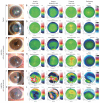Anterior Segment Swept-Source Optical Coherence Tomography-based Assessment of Corneal Refractive Profiles in Stevens-Johnson Syndrome/Toxic Epidermal Necrolysis Patients: A Controlled Comparative Study
- PMID: 40007095
- PMCID: PMC12010191
- DOI: 10.3341/kjo.2024.0106
Anterior Segment Swept-Source Optical Coherence Tomography-based Assessment of Corneal Refractive Profiles in Stevens-Johnson Syndrome/Toxic Epidermal Necrolysis Patients: A Controlled Comparative Study
Abstract
Purpose: To analyze anterior, posterior, and total corneal refractive profiles and thickness using anterior segment (AS) sweptsource optical coherence tomography (SS-OCT) in Stevens-Johnson syndrome (SJS) or toxic epidermal necrolysis (TEN) patients.
Methods: This retrospective study compared 23 eyes from 14 patients with SJS/TEN with 23 eyes from 14 age- and sexmatched controls. AS SS-OCT measured corneal refractive profiles and pachymetry. Parameters included anterior, posterior, and total corneal power values, posterior to anterior curvature ratio, maximal corneal power, and thickness profiles. The SJS/TEN group was subdivided based on corneal opacity presence (subgroup A) or absence (subgroup B).
Results: The SJS/TEN group showed significantly higher corneal astigmatism and maximal corneal power values for both anterior and posterior curvatures. Steep total corneal power and total corneal astigmatism were higher in the SJS/TEN group. The thinnest corneal thickness was lower, and its distance from the corneal vertex was greater in the SJS/TEN group. Subgroup analysis revealed that these differences were primarily attributed to the presence of corneal opacity. Additionally, automated keratometry of the anterior corneal surface showed significantly higher values, including steep, flat, and average keratometry and corneal astigmatism, in the SJS/TEN group.
Conclusions: AS SS-OCT shows significant alterations in both anterior and posterior corneal curvatures in patients with SJS/TEN. These findings emphasize the importance of considering posterior corneal curvature changes in pre-cataract surgery assessments and contact lens prescriptions for patients with SJS/TEN.
Keywords: Anterior segment swept-source optical coherence tomography; Posterior corneal curvature; Stevens-Johnson syndrome; Toxic epidermal necrolysis.
Conflict of interest statement
None.
Figures

Similar articles
-
Corneal higher-order aberrations in Stevens-Johnson syndrome and toxic epidermal necrolysis.Ocul Surf. 2019 Oct;17(4):722-728. doi: 10.1016/j.jtos.2019.07.006. Epub 2019 Jul 17. Ocul Surf. 2019. PMID: 31325631
-
[Comparison of corneal refractive power and astigmatism measured by the new anterior segment optical coherence tomographic device and Scheimpflug imaging device in age-related cataract patients].Zhonghua Yan Ke Za Zhi. 2021 Jan 11;57(1):48-55. doi: 10.3760/cma.j.cn112142-20200904-00574. Zhonghua Yan Ke Za Zhi. 2021. PMID: 33412642 Chinese.
-
A cross-sectional comparative study on chronic ocular manifestations of Stevens-Johnson syndrome and toxic epidermal necrolysis in Chinese eyes: a 15-year case series.Int Ophthalmol. 2018 Jun;38(3):1155-1160. doi: 10.1007/s10792-017-0576-5. Epub 2017 May 25. Int Ophthalmol. 2018. PMID: 28547534
-
Ocular manifestations in patients with Stevens-Johnson syndrome in Malawi-review of the literature illustrated by clinical cases.Graefes Arch Clin Exp Ophthalmol. 2019 Nov;257(11):2343-2348. doi: 10.1007/s00417-019-04421-z. Epub 2019 Jul 27. Graefes Arch Clin Exp Ophthalmol. 2019. PMID: 31352606 Review.
-
Stevens-Johnson syndrome/toxic epidermal necrolysis with severe ocular complications.Expert Rev Clin Immunol. 2020 Mar;16(3):285-291. doi: 10.1080/1744666X.2020.1729128. Epub 2020 Feb 28. Expert Rev Clin Immunol. 2020. PMID: 32045311 Review.
References
-
- Yoshikawa Y, Ueta M, Fukuoka H, et al. Long-term progression of ocular surface disease in Stevens-Johnson syndrome and toxic epidermal necrolysis. Cornea. 2020;39:745–53. - PubMed
-
- Nakagawa T, Maeda N, Higashiura R, et al. Corneal topographic analysis in patients with keratoconus using 3-dimensional anterior segment optical coherence tomography. J Cataract Refract Surg. 2011;37:1871–8. - PubMed
Publication types
MeSH terms
LinkOut - more resources
Full Text Sources
Research Materials

